High-Speed Camera Know How
Frequently asked questions
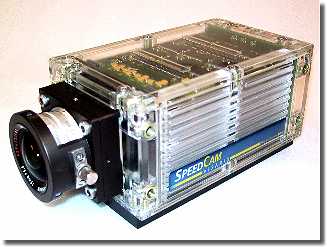
Digital HD high-speed camera, 10 000 frames/sec
Elementary questions coming up, when talking about
digital high-speed cameras and slow motion systems. Not all, but a
lot about super fast and SloMö cameras with the expertise out of
longtime professional experience.
This here is not an advertisement site - links to
various manufacturers and systems you will find in [SloMo
Links] - but should provide some
basics. Even if this field has partly lost its exclusivity during
the last years - knowledge for a good take never hurts.
Sample sequences:

More
And what do I see here?
- It's just a video camera!
Some typical high-speed camera technical data:

MORE
They are really a class of their own - professional fully
digital high-speed cameras, sometimes also named electronic HIS
video imagers, achieve in progressive mode resolution in HDTV
quality or even better more than 1 000 frames per second. Thus
more than 30 to 40 times faster than an ordinary camera. By
reducing the resolution (binning) or the format (reading a part of
the sensor area only) system depending a maximum framing frequency
of several 10 000 up to much more than 100 000 frames/sec
is possible. Even just more than 1 million frames/sec are
technologically feasible by that. (By the way there also exist the
abbreviation fps for frames per second and Hertz, short Hz, for
once per second.)
The combination with special strobe lights for multi-time
exposure permits frame rates far above this.
Single to multi-channel systems and even shock resistant versions
are available. (And this already since the last Millennium.)
Concerning expenditure and capabilities it is better to speak of
an optical measurement appliance than of a (video) camera.
Consequently several high-speed cameras additionally offer frame
synchronous analog and digital data acquisition channels.
Why one needs an extra camera for high-speed videos?
- My smartphone just shots 1000 frames per second, too!
Well, but really with the full or with high resolution at
least? And small pixel size reduces light sensitivity, dynamic and
image quality and must be compensated by lower expectations.
Already since the turn of the millennium professional
high-speed cameras have reached megapixel resolution with more
than 1000 frames per second and with reduced resolution magnitudes
above in order to mention the millions of frames per second as
appreciated by marketing. Besides there are the exact synchronization,
external real time interfaces, remote control and ... (What,
however, should in no way spoil the fun with your smartphone.)
How can the camera work with this speed?
- The sensor must just be fancy and tweaked very well!
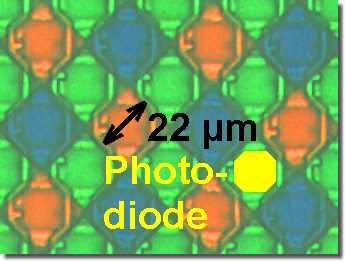
CMOS FhG/CSEM Cam 2000 sensor (magn. 1 000 x)
Well, of course, a special sensor designed for high-speed
demands is used. The performance of high-speed cameras, however,
derives less of the poor clock rate, but of the parallel structure.
Standard consumer CCD or CMOS cameras read out the sensor just at one
single spot. A frame (charges in the sensor matrix) is pushed pixel
by pixel from this read out line into the processing electronics.
Then the remaining frame is shifted in one step by one line in
order to fill this read out line again and the read out process
starts once more. And so on until the sensor is regularly read out
empty completely. Because so an information spread over an area is
transformed into a serial data stream one speaks of
serialization.
Sensors of high-speed cameras are usually designed in a very
parallel structure. Multi-frame single shot cameras expose the
sensor several times at different areas and/or just use it as
memory as well, which is read out afterwards with standard speed.
In sequence cameras the sensor offers several independent read out
channels including electronics. Casually spoken one has several
cameras bundled in a common housing. So back in time already
the VGA class CCD sensor HS0512JAQ of EG&G Reticon (about
1995) provided 16 of these read out channels, while the a bit
newer HDTV class CMOS FhG/CSEM Cam 2000 sensor (about 2001)
already provided 32 analog and the megapixel CMOS Photobit PB-MV13
(about 2003) offered 10 digital channels. The image data are
buffered in memory banks via a wide parallel bus or channel
architecture from where they are read out with standard speed.
Usually the sensor runs with a fixed clock speed of several ten to
some hundred megahertz with high pixel count imagers. So the
maximum read out rate (pixels per second) and the maximum framing
frequency (complete sensor per second), resp., are limited. If
one wants to exceed this nominal frequency, one will have to
decrease the number of pixels per frame to be read out. Just
because of the fixed respectively limited read out rate. One
achieves that by reducing the read out area step by step. Thus
quite a few thousand up to more than one million frames per
second are within one's reach. But one should take notice in respect
to smallest peepholes such a top score is more useful for sales
promotion flyers than for application. Not to mention the extreme
demands for illumination due to short times of exposure.
Digital high-speed camera: Where is a device like this used?
- It seems to be very exclusive!
No, it isn't really. Such cameras are used e.g. in automobile industry and its suppliers (crash test, air bag, tire engineering, hydraulics ...), in special mechanical engineering (packing machines, machine-tool building, robotics, lumber industry ...), in quality assurance (material testing, crack testing, ISO 9000/CE documentation, drop tests, control ...), in mass production (cable making, plug and socket connection, rack off facilities, welding facilities ...), in service use and common adjustment jobs, in printing industry and chip card manufacturing, in printed circuit board assembly, in medicine (gait analysis, rehabilitate and recovery, ergonomics, forensic ...), in sports (training, documentation and teaching, material development, movement analysis ...), in advertising and show business (TV adverts, special effects, animal films and scientific features, music videos ...), in heating and combustion engineering, in animal research, in mining, in structural and civil engineering, in sports goods industry, in kinematics, fluid mechanics science and particle tracking velocimetry (PTV), in air and space engineering (engine tests, satellite release ...), in transport and packaging industry, in military and safety engineering ... (And just for fun. ;-)
Does one really need a camera with so many frames per second?
- Camcorders and smartphones are able to provide slow motion as
well!
Indeed they are, but usually they are only capable of 25 or 30
full frames/sec, possibly 50 or 60 interlaced half frames per second
only or with even more bat with a distorting rolling shutter
distributed over several frames. In between a lot of information is
lost. High-speed cameras fill this gap with 20, 40 times and more
full frames. Therefore one will start to talk about high-speed
cameras if frame rates of more than 160 frames/sec and a serial of
least three photos in a row or with 125 frames/sec with a time of
exposure less than 1 microsecond are achieved (see e.g. EU 428/2009
Dual Use Regulation Export List paragraph C, 6A003 or US Commerce
Control List ECCN 6A003).
Practice-oriented example: a comparison of different chisels of a
turning lathe and their shavings is to analyze. The workpiece
rotates with 3 000 rpm, which are alleged ridiculous 50
revolutions per second. Nevertheless, with 25 (30) frames/sec only
each second revolution is caught. With 1 000 frames/sec each
18° a frame is acquired, thus 20 frames of a single revolution.
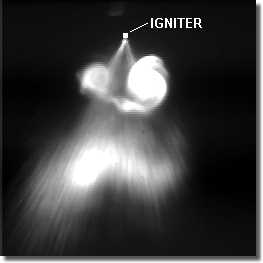
Gas and particle exhaust of an igniter
Which reminds us of the next item: the object to be shot does not stop in best pose during the picture is taken, but continues moving. A single picture covers the MOVEMENT of the object during a CERTAIN SPAN OF TIME, i.e. the time of exposure. (This as difference to a flip book. ;-)
The photo on the right shows one frame out of a
sequence shot with 1 000 frames/sec. One sees the blow-out of
an igniter (size approx. like a finger tip), as used e.g. to
start the pyro charge of an airbag or a rocket kit, about 3
milliseconds after ignition.
While the gas cloud eddies are sharply captured by a time of
exposure of 1/10 000 seconds, the blown out red-hot particles,
however, appear as stripes only, due to motion blur. The already
reduced time of exposure is not short enough to freeze their
movement.
Practice-oriented example: the workpiece mentioned above has a
diameter of 100 mm (approx. 4 inches), the exposure is
1/1 000 sec. Then 18° would be 15.7 mm (approx. 0.62
inch) the surface of the workpiece rotates on. If this is too much,
the time of exposure will have to be reduced (and/or the frame rate
has to be increased). How, you will find at
[SloMo Tips].
Concerning movement analysis one has take into account the
Nyquist-Shannon-Kotelnikov theorem of sampling: to reconstruct (an
oscillating or rotating) movement one has to use more than the
double scanning frequency than that (frequency) of the movement.
Practice-oriented example: a valve or a loud speaker let out the
chamber tone »a«, it oscillates with 440 Hertz. (That is about
the sound of the »ahhh« at the dentist.) To follow the
movement of the membrane one at least needs a frame rate of 880
frames/sec (1 Hz (Hertz) = 1/sec). As practice shows even much more.
A short comparison with military demands shows what extraordinary
frame rates must be taken into consideration there.
Practice-oriented example: one wants to see the bullet leaving the
barrel of a standard assault rifle. The v0 of the
projectile at the muzzle approximately reaches values up to about
1 000 m/sec (more than 3 000 feet/sec). Thus during
1/1 000 second the projectile moves about up to one meter
(about 3 feet) and you will get a stroke of this length as image of
the bullet if you do not reduce time of exposure. With a time of
exposure of 1/10 000 second the stroke length reduces to
just a multiple of the projectile length. That implicates if you
want to watch a bullet penetrating the target, you will need frame
rates of several thousands to some ten thousand frames/sec at least.
By the way: pistols and revolvers usually fire their bullets below
the speed of sound (approximately 340 m/sec, 1 100 feet/sec),
some shells of artillery and tank cannons, however, reach more than
1 600 m/sec (about 1 mile/sec) and additionally rotate round
their longitudinal axis.
Therefore - do not underestimate the necessary frame rate,
especially not with rotating objects and explosions.
How long is the recording time?
- Camcorders can just endlessly record on changeable memory cards or on net drives!
The limitation is not the memory medium alone. One can also
integrate a harddisk drive or connect the camera with USB or
Ethernet and so on. And it is really done. The image data, however, are
generated so fast that a common interface is not able to read out
them from a therefore necessary buffer memory. A megapixel sensor
running at 1 000 frames/sec just generates about 1 Gbyte of
data per second. Therefore the USB connector is rarely seen at fast
high-speed cameras with high resolution. See also
[SloMo Image RAM].
With moderate demands for resolution and frame rate it may be
possible to select a low end camera system capable of directly
writing the image data to a harddisk of the control device, usually
a notebook, during a longer period of time. That works with
about VGA resolution and 100 to 200 frames/sec, with USB 3.0 even
up to 800 frames/sec. With the CoaXPress interface (and expensive
infrastructure) for example one can reach more than 300 frames/sec
with megapixel resolution.
In the other direction, if one desires a usable resolution at
extreme high frame rates, even the connection between sensor and
buffer memory becomes time critical. Then it is not made of
separate ICs, but memory cells or memory areas are directly
arranged on the sensor or even around the pixel. Of course, the
recording time is further limited by that.
Isn't the recording capacity of at most a couple of seconds too
short?
- Malfunction of the machine I intend to monitor occurs after some
minutes or even hours!
Bursting water-filled balloon recorded with 1 000 frames/sec
No, actually it is not - because what goes fast, is often over
in a moment. Not to mention the image memory of digital high-speed
camera systems is organized like an endless loop buffer. Due to the
installed hardware capacity, frame rate and resolution it is
overwritten after every e.g. 4 seconds. The system is able to lie
in wait in this mode as transient recorder for hours or days. After
it gets its trigger signal the real grabbing is made and the
overwriting process is stopped. What one really gets can be
pre-selected with the trigger position. If you like to express it in
this way - one can have a glance back in the past.
Practice-oriented example 1: in a facility for filling bottles
break into pieces at a certain place but in uncertain intervals.
One is looking for the cause. The camera is adjusted towards the
scene of interest and the trigger input of the camera system is
connected to a microphone. The trigger position is set to 100%,
i.e. end position. The camera system is running in record mode
overwriting the image memory (here e.g. sized 2 seconds). The sound
of the breaking bottle releases the trigger. The recording stops
and in the image memory of the camera system remains the 2 seconds
history made before the sound has released the trigger.
Practice-oriented example 2: an analysis of the start phase of a
sprinter in a 100 m competition is to be done. The trigger of
the camera system, with e.g. 1 second image memory extension, is
set to 25%, the trigger input is connected to the starter's pistol
and the system is set to record mode. Then one catches 0.25 seconds
before and 0.75 seconds after the start shot.
Some high-speed cameras offer the chance to use the image RAM
sequentially. This partition mode means one can shot several short
independently triggered takes one after each other without filling
at once the image RAM by just a single sequence. More about
calculating the memory demands you will find at
[SloMo Data].
And finally something about duration: when you watch the 4 seconds
you have recorded with 1 000 frames/sec, you will do this
slowly - that's the idea and purpose of slow motion. With a replay
speed of e.g. 1 frame/sec you will get regular movies nearly
lasting 67 minutes, but often with a rather meager plot. Therefore
usually the systems offer the possibility to cut the sequences
before storing them on a durable storage medium.
Isn't the resolution too low?
- Smartphones and digital photo devices have several megapixels,
at all!
No, it isn't really, because one has other claims to photos.
Often detail enlargements are necessary, because the digital photo
devices offer a very restricted focal length adjustment only.
Moreover the images are stored (not lossless) compressed to
overcome the huge data flood. Thus they really have not the
advertised resolution. Often high-speed cameras are used in the
techno-scientific field and there one is just more willing to
compromise or puts emphasis on temporal resolution and less
distortion and artifacts by compression algorithms. Cinema like
quality is usually shot with noticeable lower frame rates in order
to avoid loss of impression of movement. And, of course, massive
post production.
And somehow one has to get rid of the data amount: an uncompressed
megapixel image has at least 1 Mbyte, with True Color even
rather more. And practically spoken: what device just permits to
handle and replay streams of real megapixel images with data rates
of Gbyte/sec fluently?
Besides a higher resolution just causes smaller pixel, because the
sensor size is even limited by the lens design. Smaller pixel,
however, are more susceptible to noise and usually require more
illumination.
Therefore a comparison with broadcasting and video technology is
more useful, because it is primary based in the moving frames
sector as well, and I suppose a SD / tube TV set is within
everyone's reach (or memory ;-).
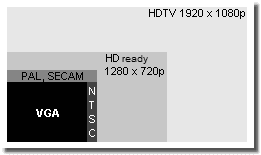
VGA, traditional and new TV formats
Erstwhile SD (standard
definition) resolution of a PAL or SECAM TV set amounts to 720
columns x 576 lines, while NTSC reaches 720
columns x 480 lines. (Reduced by S-VHS recorders to
576 x 400 and by VHS recorders to
576 x 240.)
Where one should take into account the interlace mode: one does
not see one sole image, but two half-frames inserted alternating
line by line like two combs. If you will ever have the chance,
just spool a video tape in single step mode to a fading then you
will recognize it very well. (Well, will stay with us more or less
due to rolling shutter ;-)
Somehow about Youtube middle class quality, but not pixeled, at most noisy. But it has worked. And not bad so far.
Thus the real full frames, so-called progressive scan, of simple digital high-speed cameras up to roundabout VGA resolution (640 columns x 480 lines) are not so bad at all. And the up to date megapixel-systems show in parts higher quality than HDTV (ready 1280 columns x 720 lines progressive or full 1920 columns x 1080 lines progressive) and reach or even exceed high-speed film camera standard. Especially if the resolution for Digital Cinema (2K: 2048 x 1080, 4K: 4096 x 2304) and Ultra HD (3840 x 2160) is in focus - with appropriate moderate frame rates and high financial expenses this presently is achievable.
Practice-oriented example: a movement analysis of a
javelin-throw is to be done. The scene of interest is 5 m x
5 m. Is it possible to see the javelin bending and rotating?
In an optimum image each pixel of e.g. a 512 x 512 black-and-white
sensor represents an area of less than 10 mm x 10 mm so
one can see and even read an inscription on the javelin.
As experience shows resolutions of 128 x 256 pixels in
black-and-white generally provide frames of adequate quality for
most technical evaluations. For broadcast applications the entry
levels lies (far) above 512 x 512 and with True Color,
i.e. at least 8 bit or already 10 bit per color channel of the
sensor.
Isn't there a need for a lot of experience and expensive
equipment?
- At least one does special shooting!
Usually one does not need special equipment for most industrial
and a lot of scientific shooting. (Shooting for Movies/TV is a
complete different business.) In most cases one can use standard C-mount
lenses (2/3 inch format or larger) and together with appropriate
adapters (€/$ 50.- at your local photo dealer) one can
handle with common photo lenses, too. And even facing extreme
situations, e.g. shooting in cramped locations, hard to reach spots
or under water, one benefits of the broad supply of photo and video
industry. And as illumination source a 500 W halogen
(tungsten) spotlight bought in the hardware store just around the
corner is often sufficient enough for technical sets. Some
background info you will find in [SloMo Tips].
Naturally competent support by the supplier is combined with the
systems. The demands for basic photographic knowledge concerning
technical shooting (machinery adjusting jobs ...) are not very
sophisticated. And in general the systems offer a control software
(if ever necessary at all!) easy to use.
Isn't the control too difficult and the system too susceptible
for industrial environment?
- In fact one operates a special camera at/with a Windows PC or a
Linux machine!
No it is not, in general the camera systems are designed for
their typical field of operation. So there are transportable
devices in a single box (even without demand for an additional
control computer), or ones based on tough industrial computers like
used for industrial control devices and telecommunication
systems. Or the compact and rugged camera offers stand-alone
capability and is controlled by a notebook or a remote control when
necessary only.
Also systems completely suitable for crash tests are supplied,
specified for high acceleration loads to fulfill the demands of
automotive industry for on-board crash tests and for airborne
use.
Some systems can operate without mouse and keyboard, only with
remote control, often additionally accessed by Ethernet or other
networks. Sometimes the image section of the camera is nearly
self-supporting and keeps the contents of its image memory during a
hang up, a power failure or a brown-out or the complete camera can
even operate in battery mode.
Just consider that in a big car crash test some dozen cameras
partly from different manufacturers must reliably work inside and
outside of the vehicle spread over various locations. And this
covers operating as well.
Casually spoken: everybody, who is able to operate with a video
recorder or a camcorder can handle the industrial systems. Besides
- everyone has a little bit PC experience and those, who are afraid
of working with a keyboard may be satisfied with the handful of
keys offered by the remote control.
And concerning endurance: some cameras and systems ride on crash
test sleds, partly three times a day - during month and years without
malfunction.
Isn't it possible to build a high-speed camera smaller?
- Already there are tiny webcams and surveillance cameras!
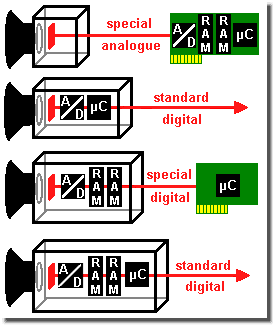
Digital high-speed camera concepts
In principle, it is. But in contrary to a comparative simple video camera inclusive mobile phones - a lot of complicated electronics are necessary to handle the generated data amounts (up to and over Gbytes per second). When transmission of data is not possible any longer, they will have to be buffered inside the camera. The additional demand for a »smart« or »intelligent« camera (i.e. with image processing capability, different memory modes and other features) causes - spoken in simple terms - the integration of an almost complete PC even possibly with a mass storage medium and buffer battery. That all needs space - and yet worse - produces a lot of waste heat. Up-to-date high end cameras can reach and even surpass about 100 W - in a housing with the size of a shoe box.
In the figure on the left some design
concepts of digital high-speed camera systems with rough comparison
of function and size. Of course, there are some mixed forms and
special solutions. So the image memory of very fast cameras can be
integrated in the sensor. The resolution and memory size, however,
are strictly limited by that.
The green card should depict a PC card (frame grabber, DSP board,
...), the red line connection possibilities (image and control
data).
Legend: RAM = image memory; µC = microcontroller or processor; A/D
= analog to digital conversion (often already integrated in the
sensor)
The standard connection can be e.g. (Gigabit) Ethernet, FireWire
or CameraLink. Even a HD-SDI interface for a mass storage device
could be possible. The special connection depends of the individual
manufacturer.
Moreover if the camera has to withstand high mechanic loads
(shock, vibration) with durability and repeatedly, one will avoid
active cooling using a fan if feasible. Only the housing is used as
passive heat sink and demands a certain (surface) size. Besides
desired robustness and shock strength just force certain material
thickness, lockpin and fastening systems, see the exploded
assembly drawing of a crash-proofed digital high-speed camera under
[SloMo HYCAM].
Besides one must take into consideration that in general due to the
shorter times of exposure compared with conventional cameras the
pixel do not become too small and therefore get too light
insensitive. That makes the high-speed camera sensors grow and
thus increases the size of cameras and lenses. (Usually not
combined with cheap costs.)
Nevertheless, or just therefore, various systems addressing different
applications exist. For instance such with one or more separate
imagers (camera heads) connected to a basic station with the main
part of the camera and control electronics inside.
What are the future trends?
- Always one wants higher resolution!
Well, indeed, semiconductor performance will increase from
generation to generation, but like now there will be limitations
due to data transfer rates. Thus processing and displaying the
images will probably cause a change of the aim: from the hunt for
speed towards improvement of the light sensitivity, less higher
frame rates, but full resolution with higher dynamic/color depth
and better image quality - Full HD 1920 x 1080p and movie industry
are just in sight. Further on the system intelligence will be
gathered in the camera head - like a camcorder. Ultra fast cameras
with Millions of frames/sec especially address the military research
sector, small (rugged) cameras industry and automotive applications.
Improved, noise reduced sensors open new application areas, e.g.
in microscopy field, biology and fluid technology.
Especially therefore there will
be further diversification - a growing market for smaller camera
heads will arise, too. They can easily be put inside a crash test
vehicle or a machine and then for multi-channel devices the system
controls, intelligence and even memory are put in a common used
control unit (again). Key word: separate camera head.
Additionally from the image processing sector (also: »machine
vision«) a lot of cameras show interesting specs for numerous
applications. Often VGA resolution or a bit above at some hundred
frames per second is sufficient enough. And these cameras are
rather inexpensive compared with the traditional high-speed
cameras. Besides they offer a moderate data amount for the image
processing in real time and case-by-case they are able to work as
long-term recorder directly sreaming their data on a harddisk.
And last, but not least: emerging from consumer market several
well known manufacturers, especially Casio (e.g. beginning with
EXILIM EX-F1), address with camcorders, cameras and meanwhile
smartphones (e.g. since Samsung Galaxy S9, iPhone 11 or higher) the
lower price and feature segment of the high-speed camera market.
With the smartphone, however, the unsuccessful turn of the
millennium idea »camera for everyone« - the portable
high-speed camera for each engineer - celebrates its revival. (See
[SloMo Links] for
detailed info and links.)
And out of this corner the up to now relatively exclusive
high-speed camera market will be rolled up. (Latest when Elon Musk
takes over. ;-) The developing of sensors is financed by the mass
market causing a massive market adjustment among the previous
manufacturers during the next years. Only absolute specialists will
survive integrating and adapting merchantable senors,
respectively.
More and more high-speed cameras are professionally used as
measurement devices with appropriate analysis software. One does
not watch the sequences only, but makes them automatic calculate
movement parameters like location, velocity, acceleration ...
This is taken into account by integrating data acquisition
channels, which are able to record and store analog and digital
signals synchronized with the frame rate. The rest is processed by
suitable evaluation software, at least in parts fully
automatically.
Why is the high-speed camera so expensive?
- A good video camera even with PC and frame grabber just does not
cost more than €/$ 2 500.-!
Well, such a video/PC system makes 50 to 60 half frames/sec. 1 000 full frames/sec are 20 to 40 times faster - so far the price seems to be more than fair. Besides high-end high-speed cameras are true camera systems - better: measurement devices - and not just a frame grabber thrown in a standard PC housing. Not to mention it is not necessary to buy such a system, one can also rent one from the manufacturer or a service provider at about €/$ 500.- to 1 500.- per day. (Or during some says of waste weather you use webcams or smartphones to create your own multi-sensor camera - see [SloMo]. ;-)
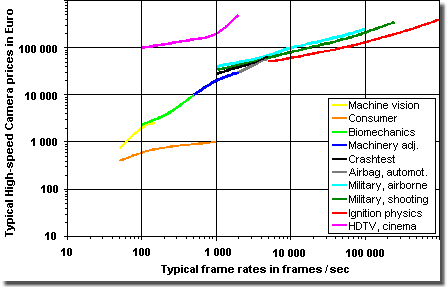
Estimated entry level prices for digital high-speed cameras (2010)
Technology steps cause a non-smooth and non linear
behavior of the costs vs. performance curves in the figure on the
right. Up to about VGA resolution and about 100 to 200 or even 600
frames/sec one can continuously move or so called stream the image
date through usual interfaces (Ethernet, FireWire, CameraLink, USB
3.0 ...) to the PC and its harddisk in real time. With higher
data rates (faster camera, higher resolution) one has to place the
memory inside the camera or must connect the camera via a special
interface device (frame grabber, DSP ...) inside the PC, see
the image left above. With frame rates starting at some
100 000 frames/sec even this is not sufficient enough. The
memory is integrated in the sensor directly grouped around each
pixel.
Special requirements for military use, crash tests or broadcast
(movie and TV) increase the costs.
The start price for new equipment with VGA resolution,
monochrome and about 500 frames/sec amounts to less than
€/$ 10 000.-. With lower frame rates of roundabout
200 frames/sec the €/$ 2 500.- mentioned above maybe
possible. For instance there are available some standard consumer
camcorders and cameras capable of some hundreds (half-/full-)
frames/sec and above with VGA resolution in short sequences and
prices of partly less than €/$ 1 000.- or even
€/$ 500.-. Or the smartphones as just mentioned
above.
One, however, has to accept really rather low resolution (often
not clearly stated in the data sheet, but drastic below full
resolution), reduced image quality, frame
rate stability, restricted adjustment and limited variability then.
Not to mention the lack of connectivity for control signals. Also
one will probably miss the remote control professional systems
offer. The upper class - megapixel at 1 000 frames/sec at
least - costs even several ten thousands of €/$. Fast (single
shot) cameras in the some 100 000 frames/sec region cost some
hundred thousand €/$. (Open end price list, of course. ;-)
Besides one should not forget the equipment, especially the expense
for illumination and the costs for control and analytic software.
A small rental and second hand market exists - just ask a
manufacturer or service provider for demo or used systems. See
[SloMo Links] for
detailed info and links.
The CCD black-and-white chip HS0512JAQ of EG&G
Reticon is opened and a RGB stripe filter on glass substrate is
adjusted with high precision (±1/4 micron) full plane on the
sensitive area optically controlled by the operating(!) sensor. The
remaining cavity is filled with special polymers to protect the
bare silicon die and the bond wires and baked in an oven. (Due to
this extent the high-g ratings during crash test applications are
guaranteed, too.)
Just click on the image on the left to see what is happening
during the operation.
Seriously: the components, especially the sensors,
are special designed with high technical expenditure built in small
series with low yield, additionally selected several times and
therefore very expensive. The sole sensor often costs much more
than a complete high-end video camera. And of course, the
development and manufacturing costs for the design in of the
complete system are not insignificant, too. Because the camera
systems have nothing to do with normal video at all. They provide
digital images in a special format. The camera heads would not work
together with a video recorder or a CCIR (= TV) monitor at all.
Just special electronics inside the camera or inside the control
unit generate the standard video signal only.
Once a qualified visitor remarked after the tour through the
lab:
That's not »high tech«, you just build »highest tech«.
Extend the [TOUR] to a buyer's guide (no advertising) for high-speed cameras.


